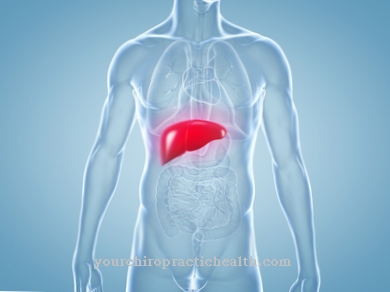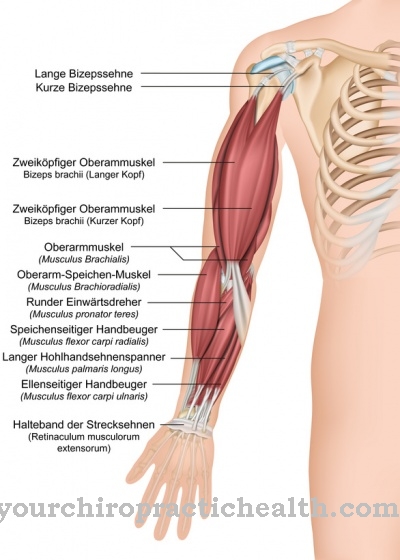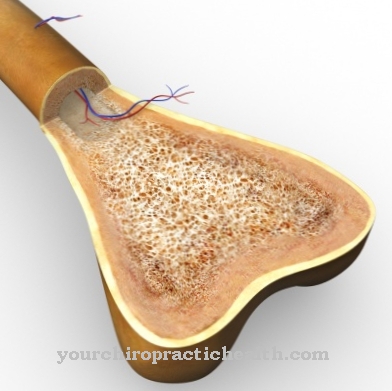At a Fracture healing it is about the healing of a bone fracture. A distinction is made between primary and secondary fracture healing. Disturbances in this process can lead to pseudarthrosis.
What is fracture healing?

The healing process after a bone defect is called fracture healing. There are two types of bone defects. Either it is a bone fracture with a complete severing of the bone or a fissure (bone tear) with an incomplete destruction of the bone structure.
The healing of a bone defect depends on many factors. First, a distinction is made between primary and secondary fracture healing. No visible callus tissue forms during the primary healing of the bone fracture. The bone heals directly. The prerequisite for this, however, is that the ends of the fracture remain in contact with each other, for example through the periosteum (outer periosteum), which is not destroyed when a bone breaks. Secondary fracture healing takes place when both ends of the bone are no longer in contact with tissue.
While the process of primary fracture healing is usually completed after three weeks, secondary fracture healing can take up to 24 months. The secondary healing process takes place over five phases. This process is also known as indirect fracture healing.
Disturbances in fracture healing can lead to deformed bones in the context of pseudoarthrosis.
Function & task
The bones form the supporting tissue of all vertebrates and also have the task of protecting the internal organs and supporting the organism in locomotion.
A bone fracture severely limits the function of the affected bone. Therefore, after the bone is destroyed, fracture healing begins immediately. As already mentioned, the process of fracture healing depends on the extent of the fracture. If both ends of the bone are still connected to one another via the periosteum, for example, the severed bones are still supplied jointly after the break. In this case, fracture healing proceeds without visible callus (scar tissue of the bone) forming.
In primary fracture healing, the precursor cells of the osteoblasts (bone cells) are deposited around the capillaries directly from the periosteum or the endosteum (inner periosteum). They form osteons (lamellae around the bone canal). The precursor cells of the osteoblasts are called osteoprogenic gate cells. The osteons restore the functionality of the bone after about three weeks.
In secondary fracture healing, the healing process does not take place directly, but rather intermediate tissue (callus) forms, which is hardened and mineralized into bone substance over a longer process. Secondary fracture healing can be divided into five phases. This is the injury phase, the inflammation phase, the granulation phase, the callus hardening phase and the remodeling phase (modeling and remodeling).
During the injury phase, force is used to destroy the bone structure with the formation of a hematoma in the fracture gap. All bone tissues are separated from one another. During the inflammatory phase (inflammatory phase) the hematoma is infiltrated by macrophages, mast cells and granulocytes. Within the hematoma, osteoblasts, chondroblasts and fibroblasts develop from pluripotent stem cells.
As part of these processes, heparin and histamine on the one hand and growth factors and cytokines on the other hand are secreted into the hematoma. This leads to a breakdown of the hematoma with a simultaneous build-up of bone-forming cells.
The third phase of secondary fracture healing is characterized by the replacement of the hematoma with granulation tissue containing fibroblasts, capillaries and additional collagen. Osteoblasts build new bones, while osteoclasts (multinucleated giant cells from the bone marrow) break down bone substance that is not supplied with blood.
In the fourth phase, the callus hardening takes place with the formation of the braided bone. This leads to the mineralization of the callus. This process is completed after about three to four months.
Finally, in the fifth phase, the braided bone is converted into lamellar bone via the remodeling process. The original bone structure is restored.
However, it is not 100% clear whether the primary and secondary bone healing processes represent different processes. The same remodeling processes in primary fracture healing may only take place to a lesser extent.
Illnesses & ailments
In connection with the healing of the fracture, there may also be disorders that delay the healing process. Fracture healing is delayed if after 20 weeks the fracture has not yet healed. The causes for this can be very large fractures, infections, inadequate bone immobilization or poor blood circulation in the affected areas. If the bones have not grown together after several weeks, this often results in pseudoarthrosis.
The term pseudoarthrosis means false joint. The pain in the area of the fracture does not decrease. Chronic swellings appear and the affected area is not able to withstand stress. In addition, there is an impairment of function and movement, which manifests itself in a permanent weakness of the affected joint.
There are many factors that can promote pseudoarthrosis. In addition to underlying diseases such as infections, liver diseases, malignancies, vascular diseases, immunodeficiencies, obesity or diabetes mellitus, external factors such as poor immobilization of the joints can lead to healing delays.
The effects of delayed fracture healing range from delayed full healing to complete no healing. The therapy was geared towards the underlying cause. Any underlying disease must be treated.
In addition to surgical treatment methods, ultrasound treatments, shock wave therapies or even gene therapies are used.




.jpg)











.jpg)
.jpg)



.jpg)






